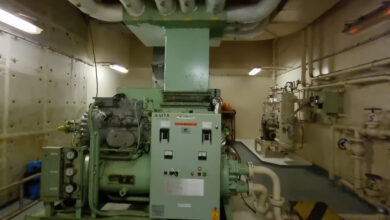Ship Refrigeration 101: How to Keep Ice Cream Frozen in the Middle of Nowhere 🚢❄️
How Refrigeration Systems Work on Ships: Because Keeping Your Meat Cold is Apparently a Big Deal 🛳️❄️
Ahoy, future marine engineers and curious souls! Today, we’re talking about the ever-so-glamorous refrigeration system on ships. Yeah, because when you’re sailing the vast oceans, there’s nothing more exhilarating than making sure the vegetables and meat don’t spoil. 🌊🍖 But hey, someone’s gotta keep the ice cream frozen, right?
So buckle up! Here’s a fun, sarcastic yet clear breakdown of how a ship’s refrigeration system works, complete with its oh-so-fascinating components. Ready? Of course, you are. Let’s set sail! 🚢
Safety Precautions (Because Explosions Aren’t Fun)
Before you touch anything:
- Don’t lose your head—compressors and valves are under pressure, and “oops” moments could involve high-pressure gas leaks. 🫠
- Keep your fingers to yourself—insulated lines = freezing cold. Non-insulated lines = boiling hot. Either way, you’ll regret touching them.
- Know your tools—you aren’t MacGyver, so no using duct tape on leaks, genius.
Step-by-Step: Meet the Mighty Components 🛠️
1. The Compressor
The “heart” of the system (and also the part that sounds like it’s summoning demons). The compressor compresses the refrigerant gas and sends it to the condenser.
- Fun fact: There’s a fan on top of the compressor to cool it down. Because even machines need to chill. 🧊
- Look closely—there are pressure gauges everywhere. If these go rogue, your day just got very interesting.
2. Suction and Discharge Lines
- Suction Side: This is the low-pressure side where the gas enters the compressor. It’s so cold they wrap it in insulation. Think of it like refrigerant winter wear. 🧣
- Discharge Side: Super hot because the gas is now compressed. Imagine shoving air into a tiny balloon—it heats up. Same concept.
3. The Oil Separator
Ever seen oil and gas hang out together? They don’t mix well. The oil separator ensures the oil doesn’t clog the system. You’re welcome.
4. The Condenser
This is where things cool down—like your boss after coffee. ☕ Freshwater cools the gas in the condenser, turning it back into liquid form.
- Look for: The thermometer and pressure gauges here. If these are out of whack, you’ll soon have a sauna instead of a fridge.
5. The Receiver
Think of the receiver as a storage tank for the liquid refrigerant.
- Pro tip: There’s a sight glass here where you can check the refrigerant level. If it looks empty, congratulations—you’re about to explain a gas leak. 🕳️
6. The Dryer and Indicator
- Dryer: Removes moisture because water + refrigerant = disaster (or just very expensive repairs). 💸
- Indicator: Shows you if the refrigerant is flowing like it should. If not, it’s time to panic… calmly, of course.
7. Control Panel
The nerve center. This is where you monitor compressors, alarms, and room temperatures.
- What to look for: Compressor running lights, anti-recycling indicators, and—if things go south—alarms. Nothing says “fun at sea” like a loud alarm at 2 AM. 🚨
Common Mistakes to Avoid 🙃
- Skipping pressure checks: If you like replacing compressors regularly, by all means, ignore those gauges.
- Not checking for leaks: You wouldn’t let your car run out of gas, would you? Same principle.
- Forgetting the oil separator: Oil-clogged pipes = disaster. Keep it clean, people.
- Ignoring control panel warnings: Those flashing lights aren’t disco signals. Take them seriously.
Wrapping It Up: Congrats, You’re Now a Fridge Genius 🎉
And there you have it! The fascinating, edge-of-your-seat process of how a refrigeration system works on a ship. From compressors screaming under pressure to condensers doing their cooling magic, everything plays its part to ensure your steak stays fresh and your ice cream stays frozen.
So next time someone asks, “Hey, how does refrigeration on ships work?” you can confidently say:
“Compress, cool, store, dry, and monitor—boom, that’s how.” 👏
Until then, stay cool, and don’t let the refrigerant escape. If you enjoyed this, go ahead and like, share, and subscribe—or just tell your friends how “cool” you are now. 😎


